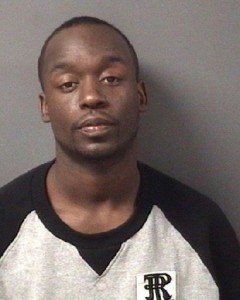An electrical engineer put on the stand by attorneys for two men suspected of killing a Mercer County corrections officer cast doubt on testimony from a detective who said a burst of light captured by surveillance tape was a muzzle flash.

Carl Batie
Roger Boyell, a forensic engineer who runs his own firm in Moorestown, explained the poor quality of the video surveillance at the Baldassari Regency banquet hall on Nov. 11, 2012 made it difficult to determine the cause of the apparent flash, which prosecutors contend coincides with a man appearing to raise his arm.
Trenton Police Detective Scott Peterson said at the trial he reviewed hours of surveillance and identified the shooter as Maurice Skillman, based on his clothing, physical looks and mannerisms in the footage.
Skillman is being tried along with Hykeem Tucker; both decided not to testify when the trial resumed Monday.
Boyell, who was the only witness to take the stand for the defense, discounted Peterson’s identification of the shooter and said it was is hard to say the spark of light on the film shortly after 1 a.m. is gunfire.
“That’s a stretch of interpretation,” said Boyell, who is being paid more than $4,000 to write a report and testify in this case. “The interpretation that it’s an actor shooting toward the balcony is not substantiated. There’s nothing there showing any shooting or any balcony or even one toward the other. It’s just a little bit of a patch of light in the background.”

Maurice Skillman
A firearms expert testified earlier in the trial he believed the shooter used a TEC-9 to mow down Mercer County corrections officer Carl Batie while he stood on the balcony of the banquet hall.
His opinion was based on ballistics tests on 22 shell casings recovered from the club and witnesses saying they heard a burst of 15 to 20 gun shots within seconds. The gun was never recovered.
Boyell said the purported muzzle flash could also be lights from a passing car, a discarded cigarette or a manifestation of the grainy footage.
“I understand there were 22 shots fired in rapid succession, but there’s only one muzzle flash although the camera is running all the time,” he said. “If there really were 22 shots, what happened to the missing 21?”
Boyell reviewed five camera angles depicting the interior, exterior and parking lot of the banquet hall and spoke to a Trenton detective about the method he used to transfer the footage to a camcorder during a minute-for-minute download.

Hykeem Tucker
He said it would have been better if investigators seized the hard drive the footage was stored on and processed it at the state crime lab, where experts could have made a “clone,” or an exact replica of the file, that may have allowed them to enhance the footage.
Peterson previously testified he contacted representatives at NFL Films to see if they could enhance the surveillance footage but they said it wasn’t possible because the footage came from the banquet hall’s antiquated system.
Boyell, an electrical engineer by trade who formerly did consulting work for the military, sparred with Assistant Prosecutor James Scott on cross examination over his opinion about the purported muzzle flash.
Scott pointed to another camera angle near the front door that captured the reaction of the crowd around the time of the purported muzzle flash. He also asked Boyell whether the apparent gunfire would appear as one burst if the firearm used could fire 20 rounds in a second.
“I don’t know if I can answer that,” he said. “It depends on camera and recorder at issue.”
Boyell said the banquet hall’s surveillance system was limited.
He said alleyway and parking lot angles could have been impacted by a “low-light phenomenon” because it was dark outside.
That means the surveillance from color cameras would appear black and white, preventing investigators from seeing certain give-away details. For example, the colors of hoodies and varsity jackets, which have been discussed at length during the trial.
Peterson testified Tucker was wearing a distinctive varsity jacket that had a decal on the right sleeve. He also said he identified Skillman as shooter, in part because he is taller than his co-defendant.
Boyell said the banquet hall’s surveillance system did not capture “minute facial expressions or walking gait.”
“The imagery can give you a false sense of what’s really there,” Boyell said. “It’s not broadcast quality. It’s not designed for an audience of millions. It’s designed for one guy sitting in a corner being a security officer.”
The jury will hear closing arguments Tuesday before they begin deliberations.